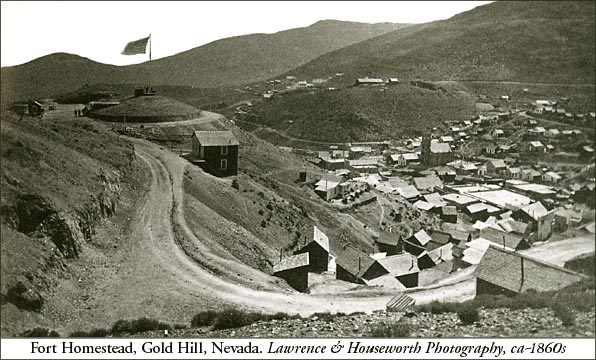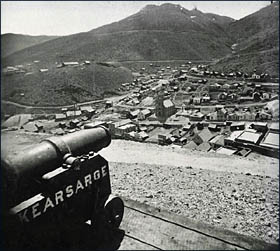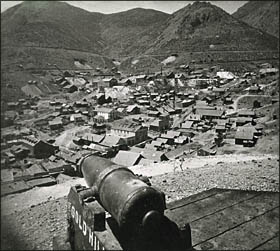
The U.S. Geological Survey Geographic Names Information System (GNIS) lists three historic forts in Storey County, Nevada. GNIS gives Fort Storey and Fort Riley similar locations in Virginia City and Fort Homestead is located by GNIS as being east of Gold Hill. We have also included a reference to a “stone fort” at Silver City, Lyon County.
By the spring of 1860, troubles between the settlers and indigenous Pah-Ute (Northern Paiute) had finally come to a head with the Pyramid Lake Paiute War. The results proved disastrous for the settlers turned militia.
“The defeat and massacre of the party, usually known as the ‘Ormsby party,’ on the 12th of May, 1860, sent a thrill of horror throughout the Pacific Coast, and to this day is regarded as one of the most important events in the early history of the State. Happening, as it did, anterior to the great war of the Rebellion, the people were unaccustomed to tales of battle and bloodshed; the slaughter of great numbers of relatives, friends and neighbors, and the conflicts, movements and losses which at a later date would have seemed trifling, then had a terrible effect, and left a lasting impression.”
--History of Nevada 1881, Thompson & West, Oakland Ca, pp. 149-150
“On the morning of May 15th [1860], after the disaster, the stragglers on foot commenced arriving at Buckland’s Station, and on horseback at Dayton, Virginia, and the other towns in the valleys farther west, creating a panic of the most remarkable character that followed them wherever they went. The horror was flashed over the line to California, and in a few hours the massacre, with exaggerated generalities, had sounded its note of alarm for the Nevadans throughout the Pacific Coast.”
--History of Nevada 1881, Thompson & West, Oakland Ca, p. 158
“At Virginia the women and children were placed in a partially completed stone building for safety, the structure being speedily converted into a fort. The place was called Fort Riley, and later the Virginia Hotel. The citizens organized, and sentinels were posted around the town.”
--History of Nevada 1881, Thompson & West, Oakland Ca, p. 158
Virginia Hotel, Fifteen Years Later:
“Yesterday morning, at 5:30 o’clock, a fire broke out in a lodging-house on A street [Virginia City] ... and it was plainly to be seen that a great fire was imminent.
“At the present writing it is impossible to give even what would approach to a correct list of losses. We can only mention a few of the principal buildings, public and private, that have been burned: Between A and B street, beginning at the south, there was burned the residence of William Wood, the house of the Eagle Engine Company, No. 3, Derby & Garhart’s livery stable, Schelweck’s lodging-house, Mrs. Cooper’s buildings, the Noyes’ building, Wilson & Brown undertaking establishment, William Mooney’s livery stable, Babcock’s saloon, the Court-house, with County Jail and all of the county offices, the Washoe Club room, Virginia Hotel, Fulton Market, Filiott’s grocery and provision store, Piper’s saloon, Miners’ Hall, Pioneer Hall, Capital lodging-house, residence of Thos. Buckner, and a great number of smaller buildings of all kinds.”
--Territorial Enterprise, Virginia City. October 27, 1875
The description below is included because it so much matches the description of Fort Homestead. Silver City is directly south of Gold Hill and just south of the Storey-Lyon county line.
“At Silver City, a stone fort was built on the rocks overlooking Devil’s Gate and the town, in which was mounted a cannon made of wood and hooped with iron, that was trained to rake the cañon below, and yawned with its cavernous mouth, portentious of an impending calamity to the Pah-Utes. After the war had ended a few citizens took that cannon back on the hill and fired it off with a slow match, thus demonstrating that the man who invented the thing had made a mistake in naming and locating it, as it proved to be an excellent torpedo, and a judicious point of location for its most approved work would have been in the center of a hostile village.”
--History of Nevada 1881, Thompson & West, Oakland Ca, p. 158
On May 24th, a force of five hundred and four Nevada and California volunteers (the Washoe regiment) march from Virginia City to engage the Pah-Ute. Here we see that Fort Storey, a.k.a., Camp Storey is placed along the Truckee River and not in Virginia City.
“The camping ground of the night of June 1st [1860] was some eight miles farther down the Truckee River, at the point since known as Fort Storey, called a fort because of slight earth-works that were thrown up at that point by the command, and named in memory of the gallant gentleman [Captain Edward Fariss Storey] killed near there a few days later...
“The bodies of James Cameron and A. H. Phelps were buried on the third of June, near Camp Storey, and the earthworks that gave the name of fort to the camp were thrown up to render the place more defensible, in the absence of the main forces, that were to go in pursuit of the enemy. The body of Major Ormsby was also temporarily buried, being later taken up and removed to Carson City for final interment. In the forenoon of the day of the battle the bodies of two men had been found and buried with Odd Fellows ceremonies at the camp.”
--History of Nevada 1881, Thompson & West, Oakland Ca, p. 161-162)



Photo Credit: Lawrence & Houseworth Photography, published 1866
“The exciting events following the death of Lincoln, the killing of the assassin, the lying-in-state, the honors to the remains of the great martyr as his remains were borne westward to his final resting-place in Springfield, Illinois, belong to the nation’s history. On the nineteenth of April [1865], the final obsequies took place...
“‘At Gold Hill,’ says the News, ‘2,000 people assembled at Fort Homestead, on the heights overlooking the town, to celebrate the obsequies of Abraham Lincoln...’”
--History of Nevada 1881, Thompson & West, Oakland Ca, pp. 170-171
Contributor: Unknown
Copyright © 1996 - The USGenWeb® Project, NVGenWeb, Storey County